The ayurvedic products market in Germany exhibits a dynamic competitive landscape, characterized by a growing consumer preference for natural and holistic health solutions. Key growth drivers include increasing health consciousness among consumers, a rising trend towards organic products, and the expanding availability of ayurvedic offerings through both traditional retail and e-commerce channels. Major players such as Patanjali Ayurved (India), Himalaya Wellness (India), and Dabur India (India) are strategically positioned to leverage these trends. Patanjali Ayurved (India) focuses on aggressive market penetration and brand awareness campaigns, while Himalaya Wellness (India) emphasizes product innovation and sustainability in its offerings. Dabur India (India) has adopted a multi-channel distribution strategy, enhancing its reach and accessibility, which collectively shapes a competitive environment that is increasingly focused on consumer engagement and product differentiation.
In terms of business tactics, companies are localizing manufacturing to reduce costs and improve supply chain efficiency. The market structure appears moderately fragmented, with several players vying for market share, yet dominated by a few key brands that influence pricing and product availability. This fragmentation allows for niche players to emerge, catering to specific consumer needs, while larger companies benefit from economies of scale and brand loyalty.
In October 2025, Patanjali Ayurved (India) announced the launch of a new line of organic skincare products, aimed at tapping into the growing demand for natural beauty solutions. This strategic move not only diversifies their product portfolio but also aligns with the increasing consumer inclination towards organic and chemical-free products. The introduction of these products is likely to enhance brand loyalty and attract a broader customer base, reinforcing Patanjali's market position.
In September 2025, Himalaya Wellness (India) expanded its distribution network by partnering with a leading e-commerce platform, significantly increasing its online presence. This partnership is strategically important as it allows Himalaya to reach a wider audience, particularly among younger consumers who prefer online shopping. The move is indicative of a broader trend towards digital transformation within the market, as companies seek to adapt to changing consumer behaviors.
In August 2025, Dabur India (India) launched a sustainability initiative aimed at reducing its carbon footprint by 30% over the next five years. This initiative reflects a growing trend among consumers who prioritize environmentally friendly practices. By positioning itself as a sustainable brand, Dabur not only enhances its corporate image but also appeals to eco-conscious consumers, potentially increasing market share in a competitive landscape.
As of November 2025, current competitive trends in the ayurvedic products market include a pronounced shift towards digitalization, sustainability, and the integration of AI technologies in product development and customer engagement. Strategic alliances are increasingly shaping the landscape, enabling companies to pool resources and expertise to enhance innovation. Looking ahead, competitive differentiation is likely to evolve from traditional price-based competition to a focus on innovation, technological advancements, and supply chain reliability, as companies strive to meet the sophisticated demands of health-conscious consumers.




















Leave a Comment